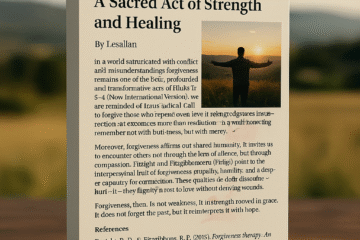Lesallan | March 29, 2025


The Transformational Symphony of Leadership: Reflections on Organizational Change, Self-Examination, and Collective Growth
Lesallan
Thank you for your thoughtful breakdown of Burke’s organizational change phases. Your discussion, particularly regarding the need for deep self-examination during the prelaunch phase, reminds me of the biblical wisdom found in Proverbs 27:17 (New International Version): “As iron sharpens iron, so one person sharpens another” (Proverbs 27:17, NIV). This verse underscores the importance of continuous mutual growth and reflective leadership—principles that are clearly echoed in the transformational approach you described. By examining one’s morals, ethics, and visions, leaders are in a better position to initiate and sustain meaningful change within their organizations (Burke, 2023).
As (I) Bostron (2025) eloquently reflects, “Change begins at the heart of the leader. When the heart transforms, the vision can truly inspire.” This insight beautifully complements your observation about the vital role of self-examination in leadership. Your discussion also aligns well with Kotter’s (2012) framework for leading change, which emphasizes the critical role of a leader’s ability to inspire and sustain change by fostering a sense of urgency and shared vision among team members. This demonstrates how reflective practices can lay the foundation for building trust, collaborative relationships, and commitment across an organization.
I am curious: given the significant resistance you mentioned can arise during the postlaunch phase, what practical strategies might you recommend for integrating reflective practices into daily leadership routines? For example, could regular sessions focused on self-evaluation and mutual feedback help to reinforce these ideals? Your example of the CEO’s initiative-taking embrace of change through social media illustrates how adaptive leadership, enriched by both modern tools and age-old wisdom, can spur innovation and fortify an organization against internal resistance. How do you think leaders can systematically foster such a disciplined yet flexible culture of continuous improvement?
Your insights perfectly illustrate that effective organizational transformation is not solely about external operations; it is also deeply rooted in the leader’s personal growth and reflective practices. This dual focus on internal development and external adaptation parallels the biblical call to mutual edification, making it a potent framework for leading organizations through turbulent times. I look forward to hearing more about how you envision embedding these reflective, value-driven practices into long-term organizational strategies.
Blessings,
Lesallan
References:
Bostron, L. (2025). A journey of faith and joy. Retrieved from [Lesallan’s reflections] https://thechristianthing.com/lesallan-a-journey-of-faith-and-joy/
Burke, W. W. (2023). Organizational change: Theory and practice (6th ed.). SAGE.
Kotter, J. P. (2012). Leading change. Harvard Business Review Press.


